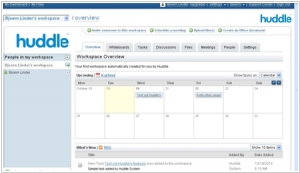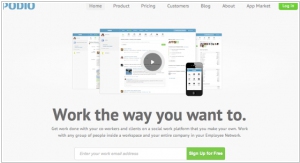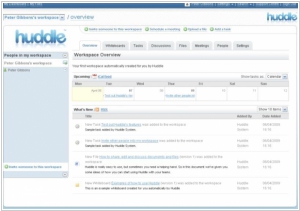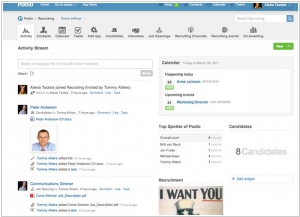Huddle vs Podio
May 27, 2023 | Author: Michael Stromann
Huddle and Podio are both popular collaboration and project management platforms, but they have key differences:
1. Collaboration Features: Huddle provides a robust set of collaboration features focused on document management, file sharing, and team collaboration. It offers secure document storage, version control, task management, and real-time collaboration features to streamline teamwork and improve productivity. Podio, on the other hand, offers a broader range of collaboration tools, including task management, project tracking, customizable workspaces, and integrations with various third-party apps. It provides flexibility for teams to create their own unique workflows and manage projects in a way that suits their specific needs.
2. Customization and Workflows: Podio is known for its highly customizable platform, allowing users to create their own workflows, forms, and applications tailored to their specific business processes. It provides a visual interface for building and configuring custom applications without the need for coding. Huddle, while it offers some level of customization, is more focused on providing a streamlined collaboration experience with standardized workflows and features.
3. User Interface and Ease of Use: Huddle offers a user-friendly interface with a clean and intuitive design, making it easy for users to navigate and collaborate. It provides a structured approach to document management and collaboration. Podio, on the other hand, has a more flexible and dynamic interface that can be customized to suit individual preferences and team requirements. It offers a range of modules and views that users can configure to create their ideal workspace.
4. Integration Capabilities: Both Huddle and Podio offer integration capabilities to connect with other tools and systems. However, Podio has a more extensive library of pre-built integrations and an open API, allowing users to seamlessly connect with various third-party applications and services. This enables users to enhance their workflows and incorporate their preferred tools into the Podio environment.
5. Pricing Structure: Huddle offers subscription-based pricing, with different plans available based on the size and needs of the organization. Podio, on the other hand, follows a per-user pricing model with tiered plans based on the number of users and additional features required. It offers a free tier for small teams, making it more accessible for smaller organizations.
See also: Top 10 ECM software
1. Collaboration Features: Huddle provides a robust set of collaboration features focused on document management, file sharing, and team collaboration. It offers secure document storage, version control, task management, and real-time collaboration features to streamline teamwork and improve productivity. Podio, on the other hand, offers a broader range of collaboration tools, including task management, project tracking, customizable workspaces, and integrations with various third-party apps. It provides flexibility for teams to create their own unique workflows and manage projects in a way that suits their specific needs.
2. Customization and Workflows: Podio is known for its highly customizable platform, allowing users to create their own workflows, forms, and applications tailored to their specific business processes. It provides a visual interface for building and configuring custom applications without the need for coding. Huddle, while it offers some level of customization, is more focused on providing a streamlined collaboration experience with standardized workflows and features.
3. User Interface and Ease of Use: Huddle offers a user-friendly interface with a clean and intuitive design, making it easy for users to navigate and collaborate. It provides a structured approach to document management and collaboration. Podio, on the other hand, has a more flexible and dynamic interface that can be customized to suit individual preferences and team requirements. It offers a range of modules and views that users can configure to create their ideal workspace.
4. Integration Capabilities: Both Huddle and Podio offer integration capabilities to connect with other tools and systems. However, Podio has a more extensive library of pre-built integrations and an open API, allowing users to seamlessly connect with various third-party applications and services. This enables users to enhance their workflows and incorporate their preferred tools into the Podio environment.
5. Pricing Structure: Huddle offers subscription-based pricing, with different plans available based on the size and needs of the organization. Podio, on the other hand, follows a per-user pricing model with tiered plans based on the number of users and additional features required. It offers a free tier for small teams, making it more accessible for smaller organizations.
See also: Top 10 ECM software
Huddle vs Podio in our news:
2014. Enterprise cloud collaboration provider Huddle raises $51M

Huddle, a major player in enterprise cloud collaboration, has announced securing an additional $51 million in funding, valuing the company between $250 million and $300 million. Huddle's success can be attributed to two key factors: its robust platform and expansive customer base. The platform provided by Huddle allows companies not only to share and exchange files but also to collaborate on them collectively, offering features like versioning control and change tracking. The platform offers a range of secure services such as team collaboration, file sharing, task management, social collaboration, and mobile collaboration. Huddle seamlessly integrates with various third-party applications and supports multiple platforms, including Office, SharePoint, and Salesforce.
2014. Huddle launches secure document publishing patform

Huddle, a cloud collaboration and content management tool, has introduced a new secure document publishing platform accompanied by a comprehensive analytics dashboard. This platform empowers enterprises to measure, track, and engage with the files they share and publish. These functionalities enhance Huddle's existing intelligent recommendation engine. With this platform, enterprises can securely publish final versions of documents as read-only to a specific audience, while simultaneously monitoring all activities related to these files. When a document has completed the team collaboration stages and is ready to be shared organization-wide, Huddle's secure publishing platform becomes invaluable.
2012. Podio - Social intranet + App buider + App store
Podio - is yet another service to create enterprise social network (like Yammer, Chatter, SocialCast, etc). May be even the definition "yet another" - is not quite correct in this case, because Podio is already one of the most successful representatives of this class. Two months ago Podio was acquired by Citrix, which competes with Microsoft, Google and Salesforce for the enterprise collaboration market. And among Podio's customers are such companies as Alcatel-Lucent, BMW, BBC, Twitter and SubWay. Podio is popular in many countries and available in 10 languages: Russian, Chinese, Brazilian Portuguese, Spanish, German, French, Italian, Danish and English. So how is Podio different from its strong competitors? ***
2012. Citrix acquires cloud-based social business collaboration platform Podio

Citrix has completed the acquisition of Podio, a Danish social business collaboration platform. Podio serves as a social network for businesses, empowering its users to create apps that enhance the functionality of the service. It can be likened to "Yammer with apps." Podio provides an App store, where users can incorporate App bundles designed for specific workflow purposes, such as CRM Management tools, Project Management tools, or individual Apps like Candidates (an app for managing job candidates), Twitter (an app for monitoring tweets), and Bugs (an app for internal bug reporting). With Podio, you can handle a wide range of tasks, from expense reports to hiring processes. Instead of following other users, the focus is on following "Spaces" where these activities take place. On the right-hand side, you can access Frequently Used Spaces, Contacts, and Calendar, while the left-hand side displays an activity stream showcasing all actions. This interface provides convenient access to all features, including the ability to add or create your own app tailored to specific tasks.
2007. Huddle Offers Space for Online Teams
Team collaboration in web work has always presented challenges, but Huddle aims to address this with its team collaboration tool. Huddle focuses on documents and scheduled tasks as the core elements of its approach. The platform features a dashboard that provides a summary of recent activities, ensuring users are kept informed through email notifications. Users can access their workspaces, known as "huddles," which contain whiteboard, calendar, filing cabinet, and team pages. The whiteboard allows for simple and accessible freeform text editing, while the calendar enables task scheduling and assignment, albeit without specific meeting times. The filing cabinet feature allows for the management of an online document library, including versioning and audit trails. Huddle's team area displays user profiles and facilitates profile updates and comments. When compared to Basecamp, Huddle's direct competitor, Huddle's dashboard feels less cluttered, and its document management and whiteboard capabilities are stronger. However, Basecamp offers additional features like milestones, chat, and time-tracking, which Huddle currently lacks. Organizations with document-centric workflows are likely to find Huddle to be a suitable solution. Huddle provides various pricing plans, ranging from a free option with limited features to a $50/month plan with more huddles, users, and storage, with customized pricing available for enterprise customers.
2007. Huddle Goes Up Against Basecamp
Huddle.net, currently in public beta, is a new web-based collaboration tool designed for teams and businesses. Its user interface is sleek and offers straightforward instructions to facilitate a smooth start. Huddle shares similarities with Basecamp and hiTask, providing document management capabilities and the option to share files with your team. The platform allows users to create multiple "huddles," each with its own set of team members. This feature is particularly beneficial for project managers overseeing multiple teams or small business owners with multiple companies or services. While the whiteboard feature is currently basic but easily editable, Huddle plans to introduce real-time collaboration for this service in the future. Additionally, upcoming features include RSS feeds, instant messaging, video conferencing, and more. It would be advantageous for Huddle to incorporate a dedicated space for jotting down and organizing notes, as many users may not view the whiteboard as the ideal tool for quick note-taking. Furthermore, the ability to create private documents for selective sharing or send private messages would enhance the platform's usefulness.





